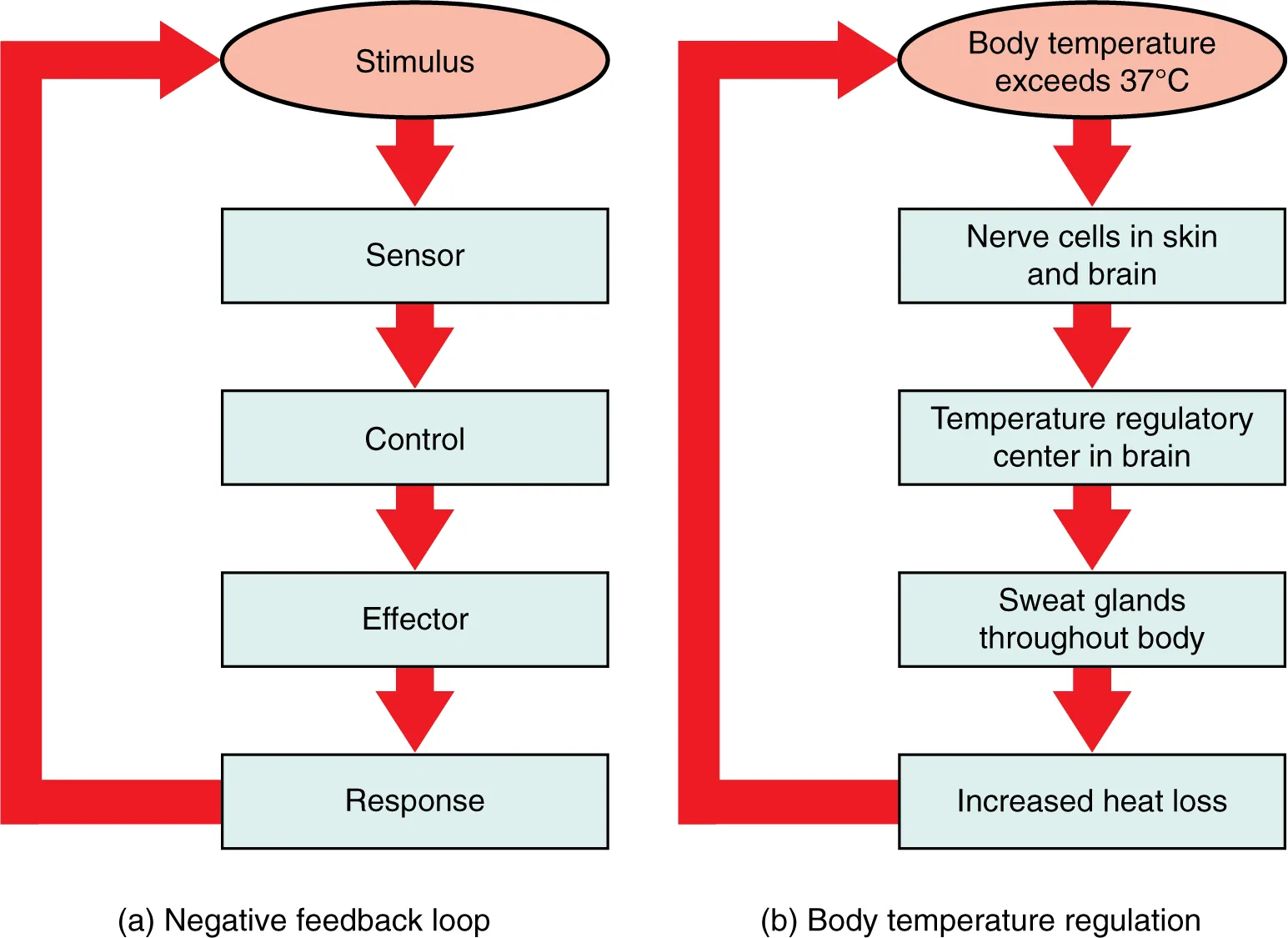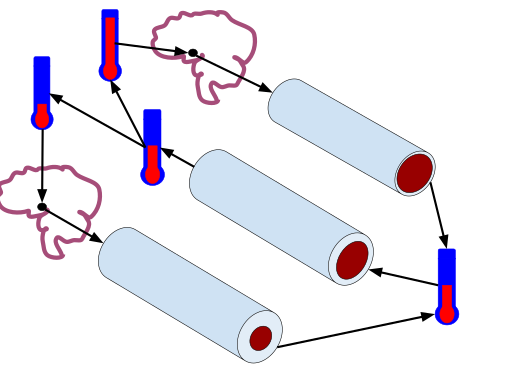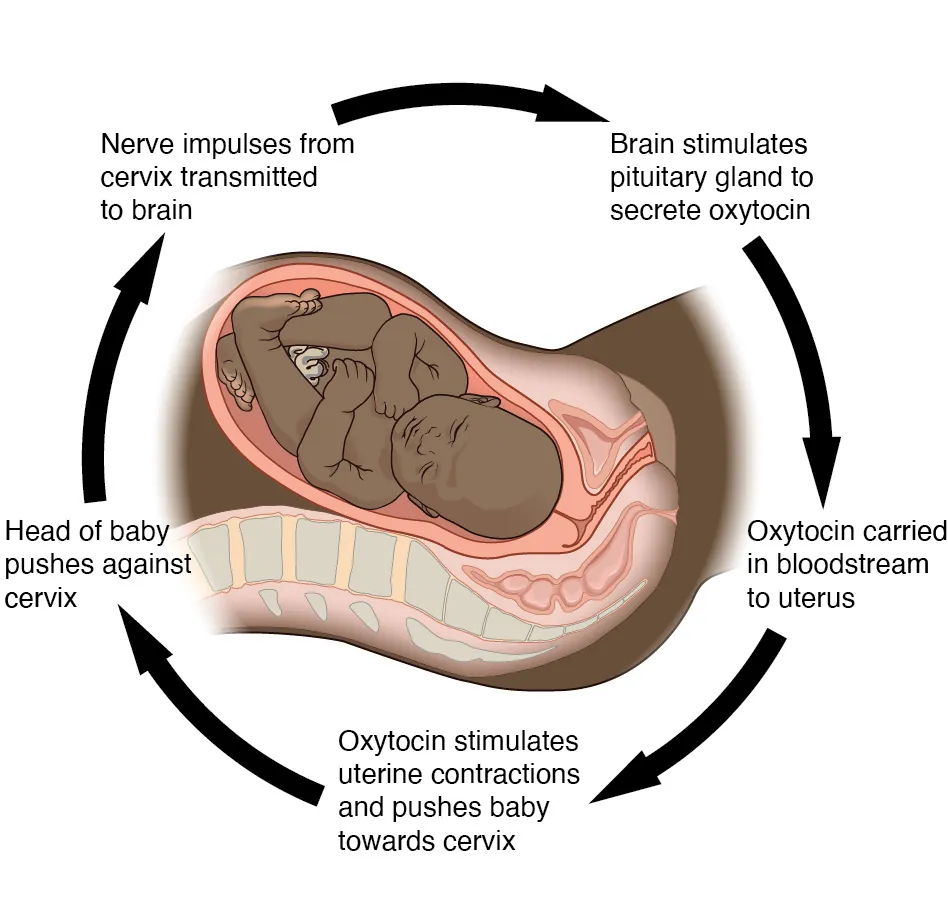OCR Specification focus:
‘Homeostasis uses receptors and effectors. Negative feedback restores conditions towards a set point; positive feedback amplifies change in specific cases.’
Homeostasis is the dynamic regulation of internal conditions within narrow limits, ensuring optimal cellular function and survival despite external and internal environmental fluctuations in multicellular organisms.
The Concept of Homeostasis
Homeostasis is central to maintaining a stable internal environment essential for enzyme activity, membrane integrity, and overall metabolic efficiency. Organisms continually experience environmental changes, both external (e.g. temperature, humidity) and internal (e.g. blood glucose concentration, CO₂ levels). To remain functional, their internal conditions must be controlled within a narrow physiological range.
Homeostasis: The maintenance of a stable internal environment within set limits, despite changes in the external or internal environment.
The process involves monitoring internal conditions, detecting deviations from normal, and initiating corrective responses. This control is achieved through complex communication systems linking receptors, effectors, and coordinating centres.
Key Components of Homeostatic Systems
Homeostatic mechanisms consist of several interdependent elements that interact to detect and correct changes in internal conditions.
Receptors
Receptors detect changes (stimuli) in the internal or external environment. These specialised cells or proteins convert the detected stimulus into an electrical or chemical signal.
Example: Thermoreceptors in the hypothalamus detect changes in blood temperature.
Example: Chemoreceptors in the carotid arteries detect changes in blood pH or CO₂ concentration.
Coordinators (Control Centres)
The coordinator or control centre, such as the brain or endocrine glands, receives input from receptors, compares it to a set point, and sends instructions to effectors.
The hypothalamus acts as the control centre for temperature and water balance.
The pancreas acts as the coordinator for blood glucose levels.
Effectors
Effectors are muscles or glands that carry out corrective actions to restore normal conditions.
Muscles may contract to generate heat (shivering).
Glands may secrete hormones, such as insulin or ADH, to regulate physiological processes.
These components form communication pathways, which can be neuronal (via nerve impulses) or hormonal (via the bloodstream).

A negative feedback system includes a receptor (sensor), control centre, and effector linked by communication pathways. When a variable departs from its set point, the system initiates a corrective response that reduces the deviation. This model underpins all homeostatic control discussed in the notes. Source.
Negative Feedback: The Core of Homeostasis
The most important principle in homeostasis is negative feedback, which acts to counteract deviations from the set point, restoring equilibrium.
Negative Feedback: A corrective mechanism that restores internal conditions to a set point when a change is detected.
How Negative Feedback Works
Change detected by receptors.
Information transmitted to the coordinator.
Coordinator sends signals to effectors.
Effectors respond, restoring conditions to normal.
Correction reduces stimulus, so response stops.
This cyclical process prevents overcorrection and maintains stability.
Biological Examples
Thermoregulation in endotherms: If body temperature rises, vasodilation, sweating, and reduced metabolic heat production lower it to normal. If temperature drops, vasoconstriction and shivering raise it.

Negative feedback in thermoregulation returns body temperature toward the set point by altering skin blood vessel calibre and heat loss. The hypothalamus coordinates effector responses that oppose the initial deviation. The diagram distinguishes the responses to warmth versus cold without extraneous detail. Source.
Blood glucose control: When glucose levels rise, insulin promotes uptake by cells and glycogen storage; when levels fall, glucagon stimulates glycogen breakdown.
Osmoregulation: Controlled by ADH, adjusting the permeability of kidney collecting ducts to maintain water balance.
Positive Feedback: Amplifying Change
Although homeostasis is largely stabilising, positive feedback reinforces or amplifies a change instead of counteracting it. It is less common but plays crucial roles in specific biological processes.
Positive Feedback: A process that increases the magnitude of a change, moving conditions further from the original set point.
Examples of Positive Feedback
Blood clotting: Platelet activation releases chemicals that attract more platelets, forming a clot rapidly to prevent excessive blood loss.
Labour contractions: Oxytocin released from the posterior pituitary enhances uterine contractions, stimulating more oxytocin release until childbirth occurs.

Positive feedback intensifies a physiological change until an endpoint is reached. In labour, cervical stretch triggers oxytocin release, which strengthens contractions and further increases stretch. The cascade ceases once the baby is delivered. Source.
Action potentials: Sodium ion influx during depolarisation triggers more sodium channels to open, creating a rapid membrane potential change.
These processes are self-limiting, as they end when the initiating stimulus is removed.
Dynamic Equilibrium and Set Points
Homeostasis maintains a dynamic equilibrium, not a fixed state. Conditions fluctuate slightly around a set point, representing the ideal value for a physiological variable.
The set point for human body temperature is around 37°C, but small oscillations are normal.
In blood glucose regulation, normoglycaemia (around 5 mmol dm⁻³) is maintained despite variations after meals or during fasting.
If deviation becomes too large or persistent, homeostatic imbalance can lead to disease, such as diabetes mellitus or heatstroke.
Interactions Between Systems
Homeostatic regulation often involves multiple organ systems acting together. For instance:
The nervous system provides rapid, short-term responses using electrical signals.
The endocrine system delivers slower, longer-lasting hormonal adjustments.
Example: In thermoregulation, temperature changes detected by skin and hypothalamic receptors trigger:
Nervous responses such as sweating and shivering.
Hormonal responses via adrenaline and thyroxine to alter metabolic rate.
This demonstrates integration between communication systems, ensuring coordinated and efficient control of internal conditions.
Importance of Homeostasis
Maintaining internal stability is crucial for:
Optimal enzyme function, as enzymes require specific temperatures and pH ranges.
Membrane integrity, since excessive heat or osmotic imbalance can disrupt membranes.
Efficient metabolism, preventing accumulation of toxic by-products or depletion of essential substrates.
Survival and adaptability, allowing organisms to live in varied environments.
Disruption of homeostatic control leads to pathophysiological conditions, including dehydration, hypothermia, hyperthermia, or metabolic acidosis.
Key Summary Points
Homeostasis is maintained through negative feedback mechanisms involving receptors, coordinators, and effectors.
Positive feedback occurs only in special cases where amplification benefits the organism.
The integration of nervous and endocrine communication ensures rapid and sustained control of physiological variables.
Stable internal conditions underpin the health, survival, and performance of all multicellular organisms.
FAQ
The set point is established by the control centre, often within the hypothalamus or an endocrine gland, based on genetically determined and physiological norms.
However, set points are not fixed. They can shift temporarily during certain conditions:
Fever: The hypothalamic set point for temperature rises to help combat infection.
Circadian rhythms: Body temperature and hormone levels fluctuate across the day.
Adaptation: Long-term acclimatisation (e.g. to altitude) can adjust set points for oxygen and CO₂ regulation.
These shifts demonstrate that homeostasis maintains a dynamic balance, not a static condition.
The body uses two types of thermoreceptors:
Peripheral thermoreceptors in the skin detect external temperature changes.
Central thermoreceptors in the hypothalamus monitor blood temperature, reflecting internal conditions.
When external temperature drops but internal remains stable, only peripheral receptors are stimulated, prompting behavioural responses such as seeking warmth. If internal temperature changes, the hypothalamus triggers physiological responses like vasoconstriction or sweating to maintain core stability.
Most physiological systems aim to stabilise internal conditions, so negative feedback dominates. It prevents extremes that could damage tissues or disrupt enzyme activity.
Positive feedback, in contrast, amplifies changes and risks pushing systems away from equilibrium. It is therefore reserved for self-limiting events where rapid escalation is beneficial, such as blood clotting or childbirth.
Negative feedback ensures long-term stability, whereas positive feedback drives short-term, goal-directed outcomes that must be terminated once complete.
Failure of either component disrupts the feedback loop:
Faulty receptors mean changes go undetected, so no corrective action occurs.
Defective effectors prevent appropriate responses, even if signals are sent correctly.
For example, if sweat glands fail, the body cannot dissipate heat effectively, leading to hyperthermia. Similarly, damaged pancreatic beta cells reduce insulin secretion, causing chronic hyperglycaemia.
Homeostatic failure often results in cumulative physiological imbalance and may progress to disease if the defect persists.
Behavioural actions often occur before or alongside physiological responses, helping maintain the internal environment efficiently. Examples include:
Moving into shade or wearing layers to regulate body temperature.
Increasing water intake when dehydrated.
Adjusting posture or activity levels in response to heat stress.
These behaviours are coordinated through neural pathways involving the hypothalamus and cerebral cortex, allowing conscious actions to support automatic, physiological feedback mechanisms in preserving homeostasis.
Practice Questions
Question 1 (2 marks)
Explain the role of negative feedback in maintaining body temperature in mammals.
Mark Scheme:
1 mark: For stating that negative feedback restores conditions to a set point when they deviate from normal.
1 mark: For describing that when body temperature rises or falls, effectors (e.g. sweat glands, muscles) act to reverse the change (e.g. sweating to cool, shivering to warm).
Question 2 (5 marks)
Describe how receptors, a control centre, and effectors work together to maintain a stable internal environment in an example of homeostasis.
Mark Scheme:
1 mark: Receptors detect a change (stimulus) in the internal environment (e.g. temperature, blood glucose level).
1 mark: The control centre (e.g. hypothalamus or pancreas) compares input to a set point and coordinates a response.
1 mark: Effectors (muscles or glands) bring about corrective actions to restore the internal condition.
1 mark: The process is an example of negative feedback, as the response counteracts the initial change.
1 mark: Appropriate example given and described, e.g. thermoregulation (vasodilation, sweating, or shivering) or blood glucose control (insulin or glucagon action).

